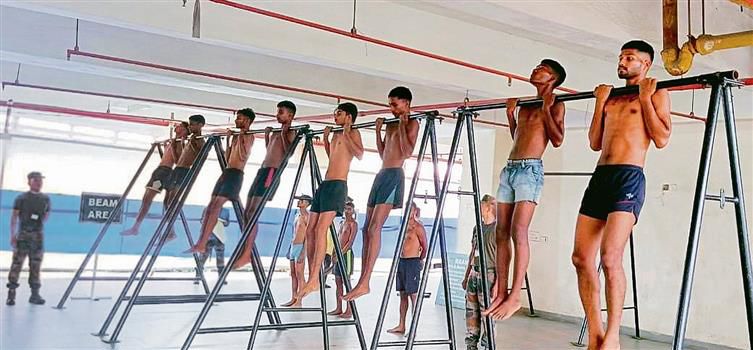Agnipath has much scope for improvement
PRIME Minister Narendra Modi may have gone overboard on Friday while speaking at the Kargil Vijay Diwas event in Drass. He accused the Opposition of politicising the Agnipath issue. The goal of the scheme, he said, was to make the Army younghellip; and to keep it continuously fit for war. “Unfortunately,” he added, “some people have made such a sensitive issue related to national security a subject of politics.”
Given the calls in the past for a younger force, we need not throw the baby out with the bathwater.
He had some more strong words to say, and whether the occasion was appropriate for them is a question. Ideally, the Opposition and the Prime Minister should have shared a common platform for the solemn observance. But that would perhaps be asking for too much.
There is no doubt that in the past 10 years a great deal has been done for reforming the military. The appointment of the Chief of Defence Staff and the creation of the Department of Military Affairs, the reformed Defence Acquisition Policy has been another, the forced indigenisation of the defence industry as well as the opening up of defence industry to the private sector and providing it 25 per cent of the defence Ramp;D funds.
But in its own way, the most ambitious is Agnipath. Under this scheme, an Agniveer is recruited between the ages of 17 and 21, s/he serves for four years and thereafter will leave with a severance package; 25 per cent of these ‘retirees’ would be offered re-enlistment for a further period of 15 years and more, and presumably be entitled to a pension. As for the bulk of the Agniveers, 75 per cent of them would have options of various government jobs where they would be entitled to preferential recruitment.
Controversy arose over the scheme when, in late 2023, former Army Chief Gen MM Naravane said in his yet to be published memoir that the scheme was a “bolt out of the blue for the Navy and the IAF” and that he had proposed a four-year term only for the Army, and that too with retaining 75 per cent personnel and letting go 25 per cent. But the Ministry of Defence (MoD) reversed this to releasing 75 per cent and retaining only 25 per cent.
There has been a problem with Agnipath from the outset. Because of politics, and both sides have played it, the main question often is: What (more) can we do for the Agniveer? But we do not quite have the answer to the other question: what can or should the Agniveer be doing do for the Army?
The primary argument is that Agnipath will lower the average age of the Army. A government affidavit claimed that India had the highest average age, 32, for below officer rank personnel as against a worldwide average of 26. But the recruitment age in the Army has always been in the 16.5-21 age group for decades. By releasing 75 per cent and infusing a new lot of personnel every cycle, the scheme expects to lower the age of the military. But as we noted, what will it get in return?
There are certain realities of Indian recruits. When young men or women were recruited earlier, they were often underweight and undernourished and came from a diversity of backgrounds. Nine months of basic training just brought them to scratch in terms of physique and discipline, and thereafter there was need for professional training as an infantryman of more technical jobs as a handler of tanks, artillery, air defence systems. This could require anywhere up to another year for just proficiency.
Now, the Agniveer is inducted into the Army with just six months of training. Given the rural background, levels of education and the age of induction, it is unlikely that an Agniveer comes in with any saleable skills. In better-off countries, a recruit would come in with a skill like driving, but in India that alone could take three months.
Former Admiral Arun Prakash has noted that while Agnipath may be useful for the Army, where infantry personnel are not too much into technology, it would be a major problem for the Air Force and the Navy, where “at least 5-6 years are required before a new entrant can acquire enough hands-on experience to be entrusted with the operation or maintenance of lethal weapons systems and complex machinery and electronics”.
The government has denied that the Agnipath scheme was motivated by anything else other than the need for a younger profile of the military. In retrospect, the government needs to be upfront on the fact that it was indeed motivated by the public finance aspects of the scheme which will, however, kick in only after a decade. The pension bill which, according to the latest budget consumed Rs 1.41 lakh crore or 22.7 per cent of the defence budget is a millstone around the military’s neck.
Given the calls in the past for a younger force, we need not throw the baby out with the bathwater. Instead of ending the scheme, the government needs to modify it to overcome shortcomings such as that of training and skill development. It may be a good idea to extend the Agniveer’s tenure from four to seven years, an idea that has been around for some time. This will ensure enough time for training and also providing effective contribution to the service. The Agniveers will be between 24 and 28 years when released, which is ideal for the many opportunities that are opening up, somewhat belatedly, for them.
And remember, of course, that the 550-odd who died in the Kargil War in 1999 were trained, hardened and dedicated soldiers, not Agniveers. That kind of test still awaits the scheme.










